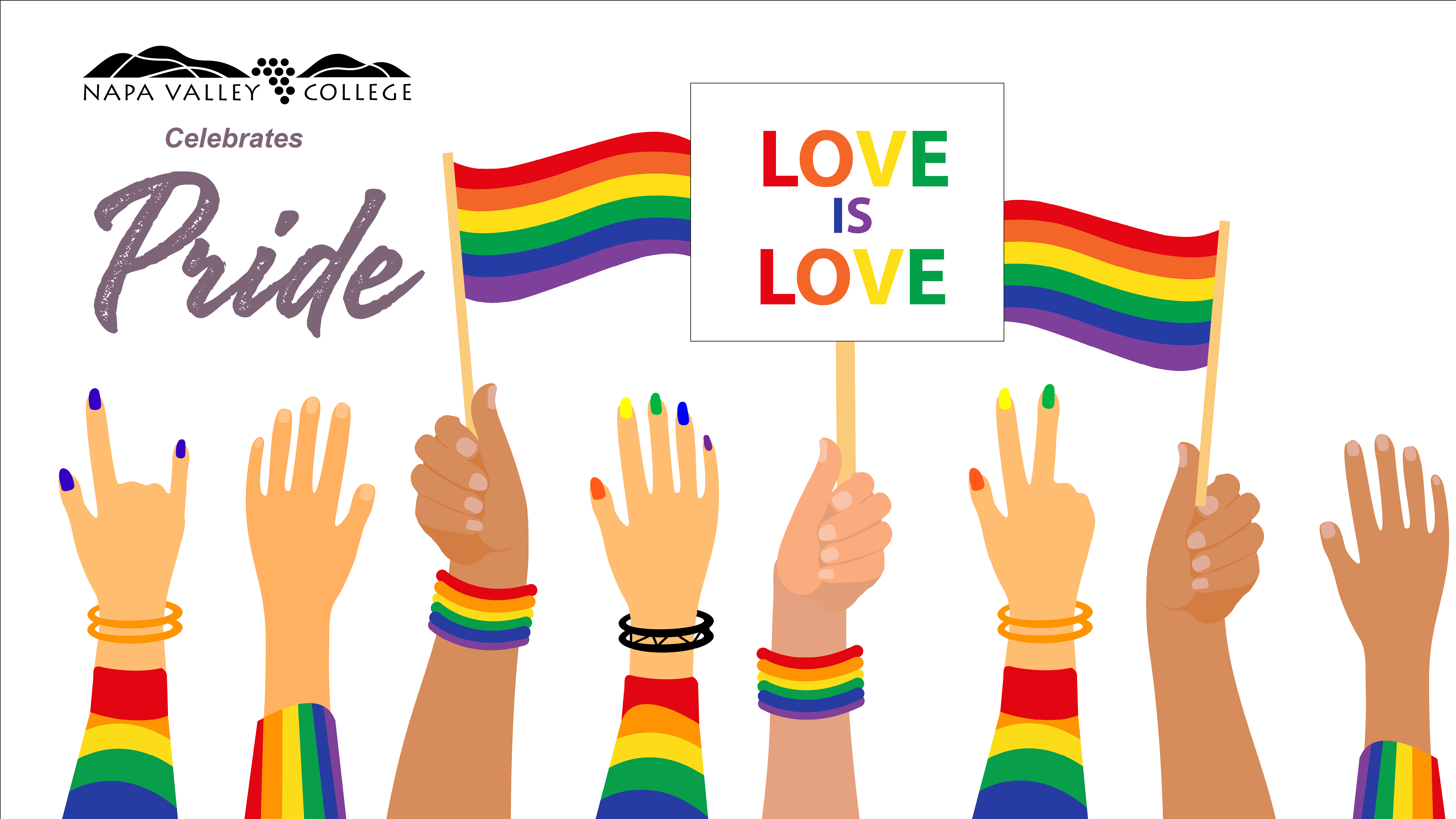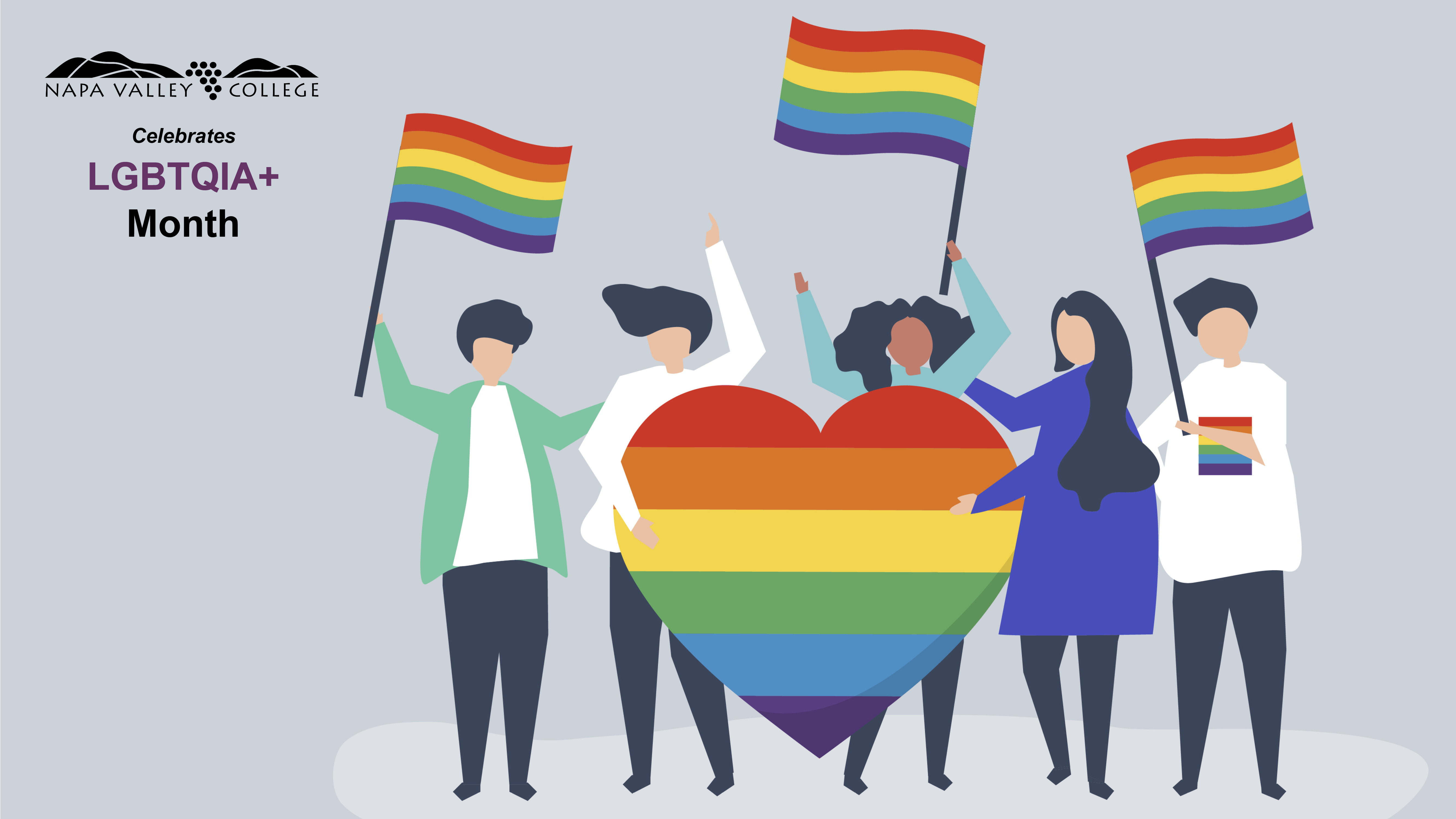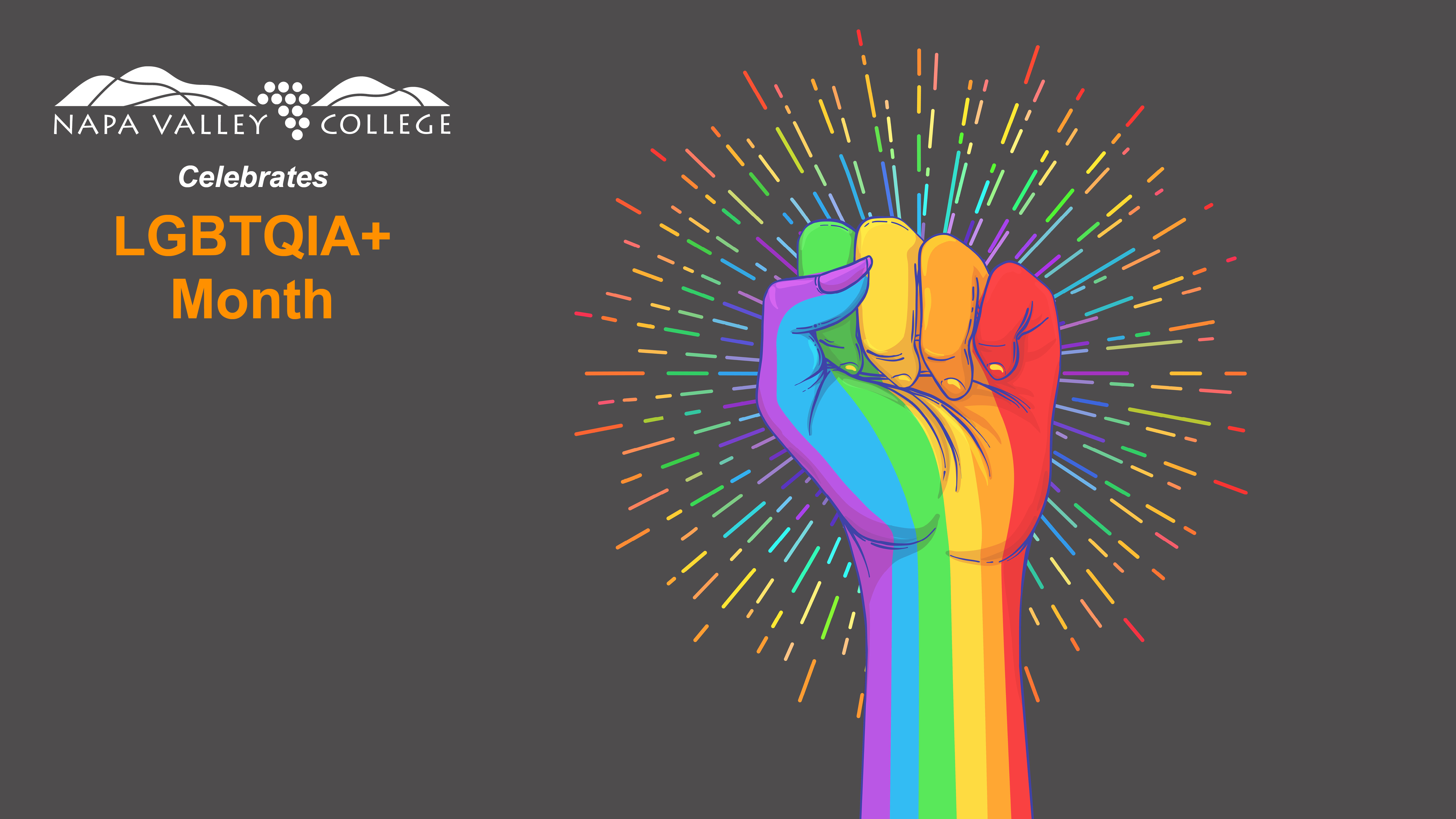Pride Month
Zoom backgrounds to download and use in celebrating and supporting Pride Month.


Note: Suggest to make the list of accordion drop-down menus with titles not specific soley to the years they were announced. If, say, on this page, we were to write "Why the Rainbow Flag? 2023 Announcement" and "What is Pride Month? 2022 Announcement", then we would also be able to include accordion drop-downs for announcements that are not associated with a year published.
Maybe add links to associated campus orgs like Learning Communities, future Affinity Groups, etc.
Past Pride Month Announcements
6/1/2023
Today marks the beginning of Pride Month, and I want to share with you all the following
message sent to our new Pride Learning Community members. Thank you, Greg Miraglia,
for this history on the origins of the Pride Flag!
In community and solidarity with our LGBTQIA+ family,
Dr. Patricia van Leeuwaarde Moonsammy
Senior Director, Diversity, Equity, and Inclusion
Today Napa Valley College raised the Pride flag to honor Pride month (June 1 through 30). The flag flying is the original 6-color version of the original Pride flag designed by Gilbert Baker in 1978.
The following is some history and explanation of the meaning behind the Pride flag as designed by Gilbert Baker.
1978 - The original 8 color flag
The original rainbow flag was conceived with 8 stripes. Gilbert Baker assigned specific meaning to each of the colors as seen in the diagram on this page.
But the Rainbow Flag that has been used predominantly through history since has only 6 colors. This modification had nothing to do with the flag’s meaning, but came about out of necessity due to fabric supply and logistics.
After the assassination of gay San Francisco City Supervisor Harvey Milk on November 27, 1978, demand for the rainbow flag greatly increased. Unfortunately, hot-pink fabric became increasingly unavailable. To meet the demand, the Paramount Flag Company, of which Gilbert Baker was an employee, began selling a version of the flag using stock rainbow fabric with seven stripes. The flags flew off the shelves of its retail store on the southwest corner of Polk and Post.
1979 - The origin of the 6 color flag
By 1979, circumstances made it necessary to modify the flag again. When hung vertically from the lamp posts of San Francisco’s Market Street, the center stripe was obscured by the post itself. Changing the flag design to one with an even number of stripes was the easiest way to rectify this, so the turquoise stripe was dropped, which resulted in much celebrated six stripe version of the flag — red, orange, yellow, green, blue, and violet.
By it's very definition, the Pride flag was designed to represent ALL people; all sexual orientations and gender identities. The elements represented by each color are present in all of us. Gilbert always intended this Pride flag to be a representation of the entire community. While many other flags and variations have been created since the original, each of the new designs represents one or more segments of the LGBTQ+ community, but they do not represent all people in the same way. Gilbert Baker never trade marked the Pride flag or made a single penny for it. He believed that this flag belonged to everyone. This is not true for other flag designers.
6/1/2022
Today marks the first day of Pride Month, a time to recognize and celebrate the achievements of the LGBTQIA+ community, to reflect upon the histories of resilience in the face of persecution and violence perpetrated against queer communities, and to expand our knowledge of LGBTQIA+ issues. Today we raised the Pride Flag in front of our campus to honor and celebrate the lives, advocacy, and achievements of the LGBTQIA+ community.
PRIDE MONTH
June 28, 1969, is a significant date in the development of what we now celebrate at
Pride Month. On this date, patrons and supporters of the Stonewall Inn in New York
City staged an uprising to protest ongoing police harassment and persecution of what
was then known as the gay community. Marsha P. Johnson, a Black, trans, bisexual
woman was a significant leader of the Stonewall uprising against police harassment—an
uprising that would last six days. “Many eyewitnesses have identified Marsha as one
of the main instigators of the uprising and thus, some have recognized her as the
vanguard of the gay liberation movement in the United States” (Anti-Defamation League/ADL).
The Stonewall uprising sent a clear message that the community would defend spaces
where LGBTQIA+ people could gather and be open about their identities without fear
of harassment and arrest. “The Stonewall uprising marked the beginning of a movement
to outlaw discriminatory laws and practices against LGBTQ Americans” (ADL).
According to the Library of Congress, “Lesbian, Gay, Bisexual, Transgender and Queer (LGBTQ) Pride Month is currently celebrated each year in the month of June to honor the 1969 Stonewall Uprising in Manhattan. The Stonewall Uprising was a tipping point for the Gay Liberation Movement in the United States. In the United States the last Sunday in June was initially celebrated as "Gay Pride Day," but the actual day was flexible. In major cities across the nation the "day" soon grew to encompass a month-long series of events.”
“Today, celebrations include pride parades, picnics, parties, workshops, symposia and concerts, and LGBTQ Pride Month events attract millions of participants around the world. Memorials are held during this month for those members of the community who have been lost to hate crimes or HIV/AIDS. The purpose of the commemorative month is to recognize the impact that lesbian, gay, bisexual and transgender individuals have had on history locally, nationally, and internationally”.
WHY LGBTQIA+?
Attached are Zoom backgrounds, created by the Public Affairs and Communications Office. You’ll notice that two of the Zoom backgrounds include the language, Napa Valley College Celebrates LGBTQIA+ Month. The letters in this acronym stand for Lesbian Gay Bi-Sexual Transgender Queer Intersex and Allies or Asexual. The “+” sign denotes that this list is incomplete and that there are more identities and orientations that are not included in the acronym, but which are to be respected and honored. Language, like culture, is a living entity that is constantly evolving to communicate the ideas, concepts, and realities of the historical moment in which it is being used. The New York Times article, “The ABCs of L.G.B.T.Q.I.A.+“ by Michael Gold, discusses the evolution of terminology to refer to the wide range of gender identities and sexual orientations that comprise our world and provides a glossary of terms currently in use in academia, in social justice and human rights advocacy circles, and used by members of the LGBTQIA+ community to refer to themselves and their realities. The article can be found here: The ABCs of L.G.B.T.Q.I.A.+ - The New York Times (nytimes.com)
LGBTQIA+ ADVOCACY at NAPA VALLEY COLLEGE
LGBTQIA+ advocacy and educational programming at Napa Valley College has been ongoing
for many years. Below is a link to slides of a timeline of important moments in this
social justice work at the college, beautifully documented and detailed by Heather
Richter in the Office of Student Life.
Please take time during the month of June to educate yourselves about the history
of LGBTQIA+ activism and culture, and to celebrate the courage, resilience, and beauty
of the LGBTQIA+ community.


References:
- Library of Congress: https://www.loc.gov/lgbt-pride-month/about/
- Anti-Defamation League: https://www.adl.org/resources/tools-and-strategies/lgbtq-pride-month-and-education-resources
- Gold, Michael. The ABCs of L.G.B.T.Q.I.A.+ - The New York Times (nytimes.com)
Regards,
Dr. Patricia van Leeuwaarde Moonsammy
Senior Director, Diversity, Equity, and Inclusion
Downloadable Zoom Backgrounds
Below are some high quality Zoom backgrounds you can download. Just right click them, and save them to your computer.




